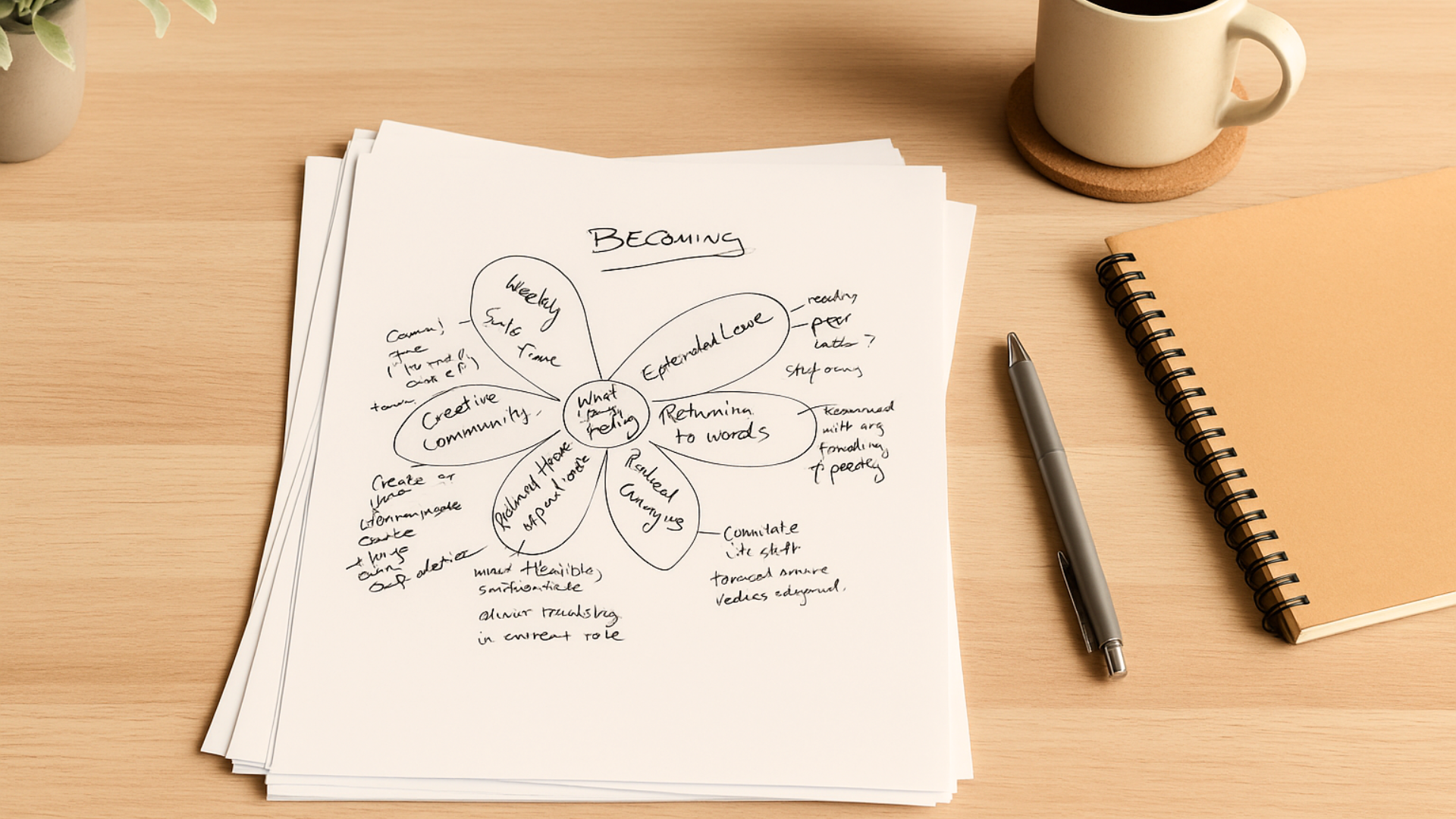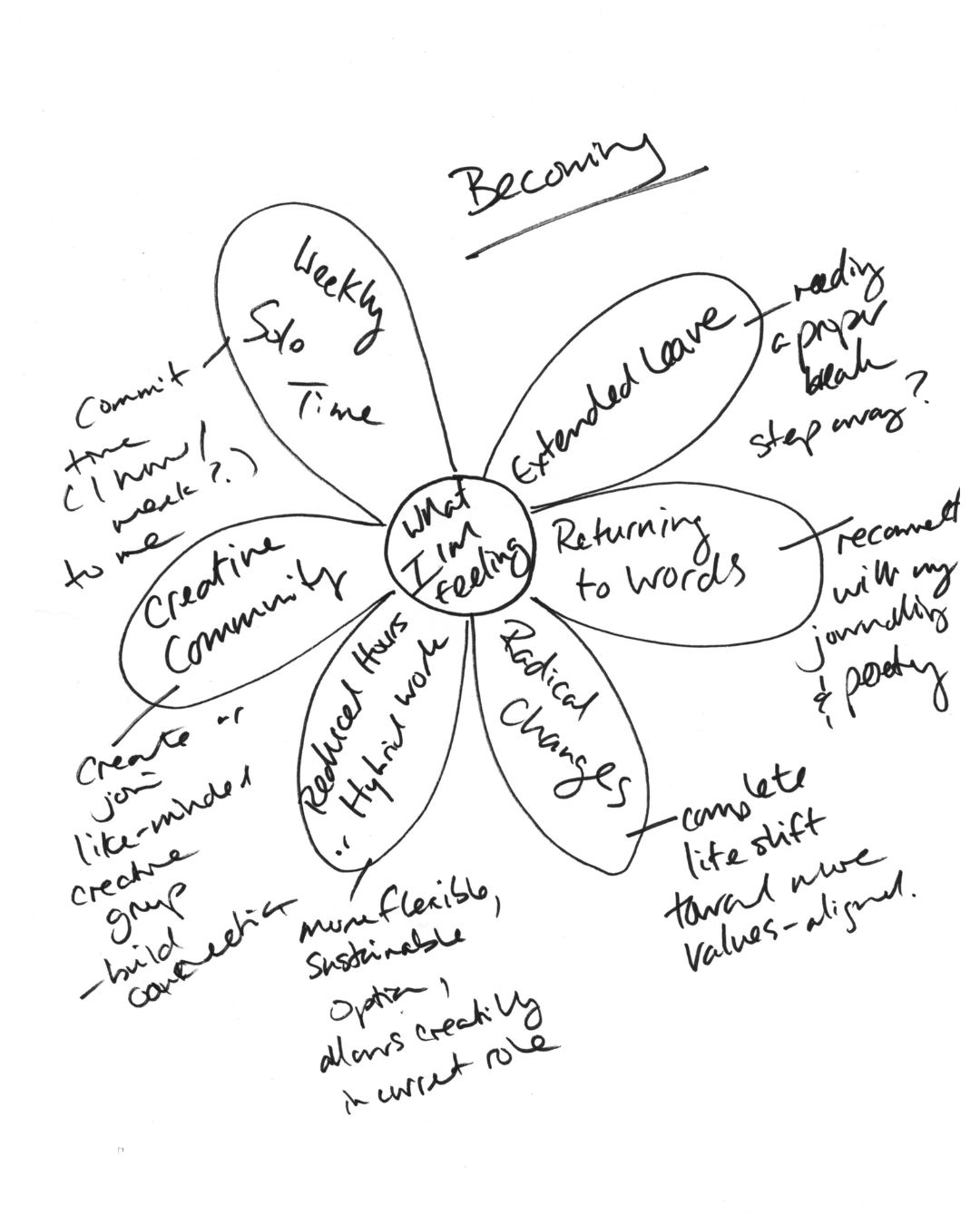When You Don’t Know What You Want, Try Drawing It

Natalie came into our session with a quiet kind of ache.
On paper, her life looked fine. A stable job in environmental science. A well-run household. Years of experience in a field she once loved.
But something had shifted. And she couldn’t quite explain it—she could only feel it.
She said, “It’s not that anything’s wrong. It’s more like… I don’t recognize myself anymore.”
I hear this often from women in STEM. After years of managing deadlines, solving complex problems, and carrying invisible responsibilities at work and home, something inside starts whispering for change. Not a total life overhaul. Just a little space. A pause. A moment to figure out what’s next.
But when you don’t know what you want, where do you even start?
That’s when I turn to a visual tool called the Daisy of Options.
A Simple Drawing for When You’re Feeling Stuck
The Daisy of Options is one of my favourite coaching tools. It’s a gentle drawing exercise that helps you get unstuck—not by forcing a decision, but by opening up space for possibility.
Here’s how it works:
- Draw a small circle in the centre of your page. Inside it, write the question or feeling you’re holding.
- Around that circle, draw petals. Each petal is an option, a nudge, or an idea connected to your theme.
- Don’t worry about whether they’re realistic or logical. Include anything that’s been quietly tapping at your attention—curiosities, hopes, or even contradictions.
This isn’t about making the right choice. It’s about putting your thoughts on paper so you can see what’s been swirling in your head.
Natalie’s Daisy
In the middle of her daisy, Natalie wrote, “What do I do with this feeling?”
She called her drawing Becoming.
Not Fixing. Not Deciding. Just… Becoming.
From there, she added her petals, one by one. No pressure. No expectations. Just options:
- Extended Leave – not a vacation, but a real pause from work
- Returning to Words – journaling, poetry, reconnecting with her voice
- Radical Change – maybe shifting careers, even if the path wasn’t clear
- Reduced Hours – scaling back to breathe again
- Creative Community – joining others who make time for creative play
- Weekly Solo Time – one hour for herself, no goals, no outcomes
Each petal opened the door to a new question: What would this feel like? What’s in the way? What part of me is asking for this?
When she finished, Natalie sat quietly for a moment, looking at the page.
“I thought I needed a big answer,” she said. “But maybe I just needed to see that I have choices.”

Why Drawing Helps When Thinking Doesn’t
If you’re used to solving problems with logic, it’s easy to stay stuck in your head. Thinking is your default. And it’s one of your greatest strengths.
But when what you’re grappling with isn’t a clear problem—when it’s about identity, emotion, or uncertainty—thinking harder can start to work against you.
Drawing helps shift that. It slows you down. It gives your intuitive and analytical minds a chance to work together. And it lets you make something visible out of something vague.
Natalie’s daisy didn’t give her a concrete plan. But it gave her space to reflect without judgment. And that made room for the next step.
One Petal at a Time
When I asked Natalie which petal she felt ready to explore, she didn’t hesitate.
“Weekly Solo Time,” she said. “One hour a week. I can start there.”
And she did. Not because it was the perfect solution. But because it felt like a beginning. It helped her reconnect with who she was outside of all her responsibilities.
That’s the power of drawing. It doesn’t give you the answer. It helps you see the wisdom you already carry.
Try This: Your Own Daisy of Options
If you’re in a place of not-knowing, try making your own Daisy of Options.
Here’s what you’ll need:
- A blank sheet of paper
- A pen or pencil
- A few quiet minutes
How to begin:
- Draw a circle in the centre of the page. Write your central question or feeling inside it.
- Add petals around it. Each one can be a wish, an idea, or even something that feels too bold to say aloud.
- When you’re done, take a moment to look at what you’ve created.
Ask yourself:
- Which petals feel true for you?
- Which ones sound like someone else’s expectations?
- Which one feels most possible to explore, just for now?
You’re not choosing your future. You’re simply noticing what’s ready to be seen.
Final Thoughts
Natalie’s daisy didn’t change everything overnight. But it changed the way she held her uncertainty. It gave her a place to reflect with clarity and compassion.
If you’re standing in that foggy, in-between space, I want you to know it’s okay not to have all the answers. You don’t have to figure it out in one step.
Sometimes, the next right thing is to pause, pick up a pen, and draw your way into the conversation.
You might be surprised by what appears.
Want more creative tools to help you reset and reconnect?
Subscribe to The Creative Shift, my free weekly newsletter for women in STEM. You’ll get simple art-based practices, reflective prompts, and real support for the parts of you that often get overlooked.
You don’t have to do this alone. Let’s take it one step—and one petal—at a time.